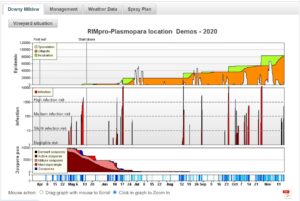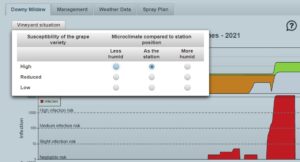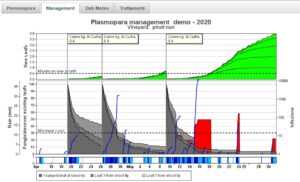Downy mildew (Plasmopara) model
Downy mildew is the most important disease in wine production. The RIMpro-Plasmopara model follows the evolution of the disease in a vineyard during a growing season. The model simulates the increase in disease during different successive cycles. Most of the mildew models are “event-based” models. These models only take into account the weather for a given day and do not include the disease history for the season. Event-based models cannot provide a quantitative assessment of risk during the growing season.
The video with detailed explanations about the model is available here
The model
In the bar below the graph, dark blue represents the periods when your weather station recorded rain. Light blue is the period when the leaves are wet, based on your records of rain, relative humidity and humidity.
The lower graph shows the different stages of oospore maturation and zoospore production. For specialists, it shows the period during which primary infections are possible.
The middle graph shows the risk of infection and is used to make decisions about the management of the disease.
The first infections result from primary spores. These spores mature in the soil and are ejected into the canopy by the rain. After successful infection and an incubation period, secondary spores are produced by the “oil spots” that have developed on the leaves. The infection graph does not distinguish between a primary or secondary source of zoospores. For the plant and for disease management, an infection is an infection, regardless of the source of the spores.
The upper graph shows the level of disease that would occur if no fungicide were applied. When fungicides are sprayed, the same development takes place at a lower level. Green indicates that an infection has occurred but is not yet visible. Where the green turns orange, the incubation period ends and oil spots become visible in the vine. During hot, humid nights, the oil spots produce spores on the underside of the leaves (modeled here in white). The rain can splash these spores onto other leaves and create new infections. The more spots, the more secondary spores are produced, the more serious the following infections are. Hence the exponential increase in the disease.

There are 2 factors that you can change in this model :
Microclimate
In vineyards on the hillsides, infections are more severe towards the bottom of the valley where the humidity of the air during the night is higher, and less severe near the top where the wind dries up the soil and the canopy. Your weather station is not always in a microclimate representative of the vineyard. The model can correct the calculations according to the microclimate of the vineyard.
You can choose to operate the model with the humidity recorded by the station (= by default), or for a microclimate a little more humid, or a little drier than the position of the weather station. This parameter slightly increases or decreases the humidity of the air recorded by the station for all stages of the biology of the infection.
Susceptibility
Most European grape varieties are very susceptible to downy mildew. However, organic growers tend to plant less susceptible varieties. Under equal infection conditions, the efficacy of infection on these varieties is lower than that of highly susceptible varieties. We have also found that under equal sporulation conditions, the more resistant varieties produce fewer secondary spores. These differences mean that the mildew epidemic develops more slowly on more resistant varieties.
You can choose to calculate for very sensitive (= by default), less sensitive or resistant grape varieties.

Treatments
You can record fungicide applications for each individual vineyard. The list of fungicides is based on the products available in your country.
The estimated protection from your last fungicide treatment depends on:
- the new unprotected leaf surface since your last treatment
- washout and dilution of the fungicidal cover by the growth of old leave

Interpretation of the graphs :
Infections below the value “10” are negligible infections.
In practice, most growers intervene with a treatment when the infection value approaches the “100” threshold.